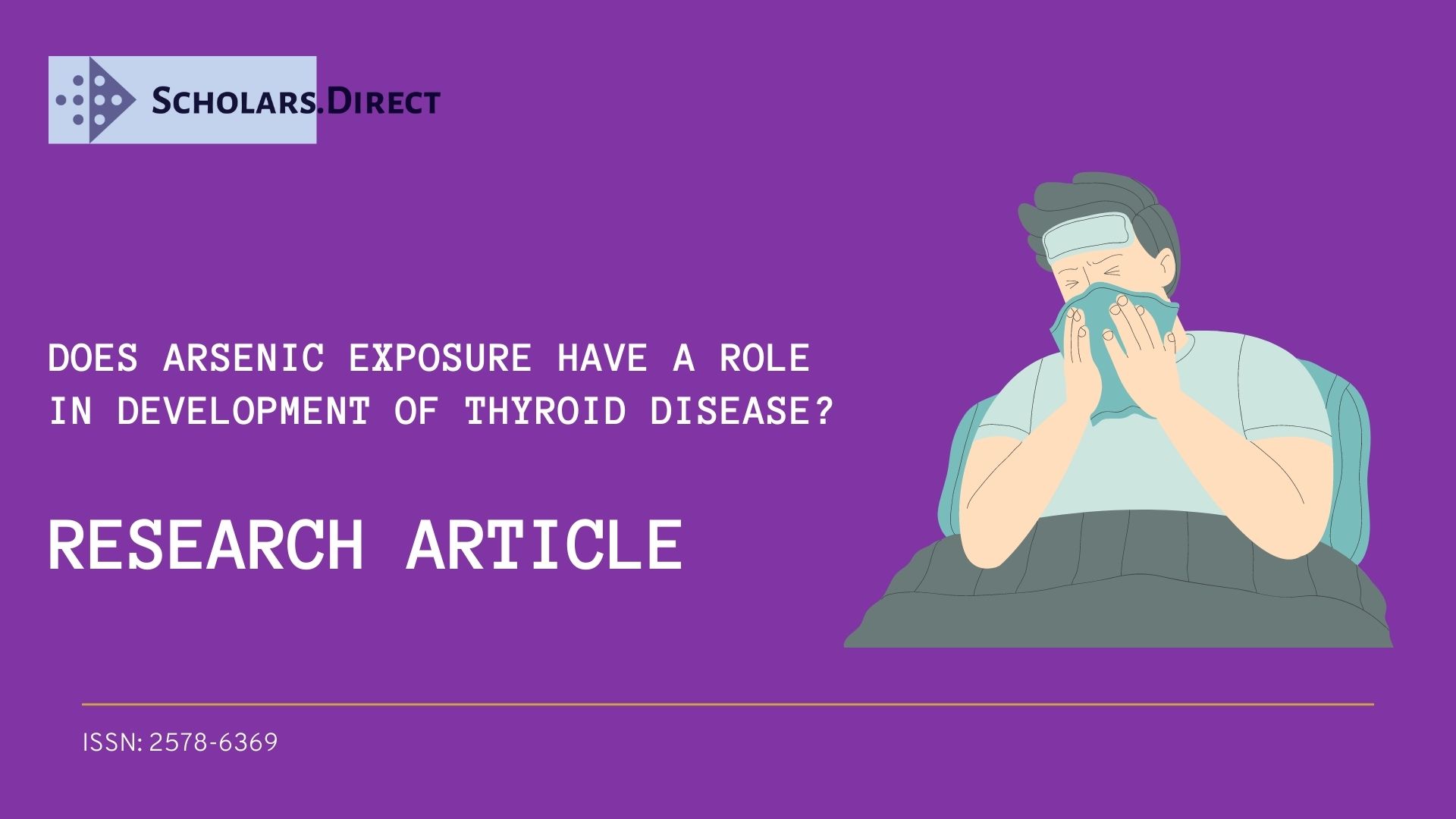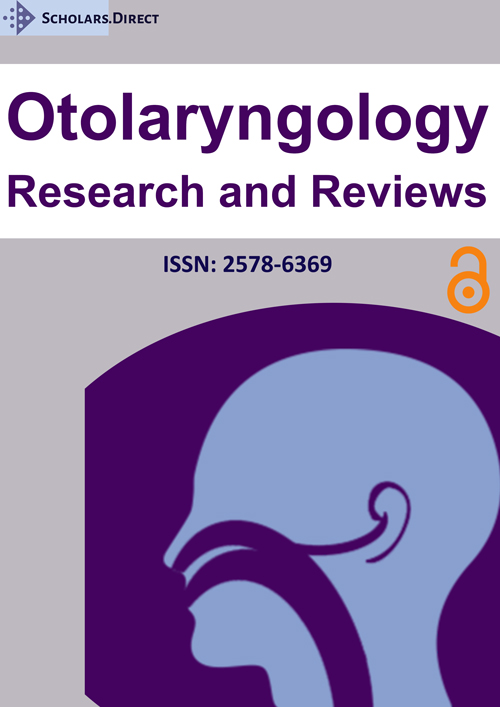Does Arsenic Exposure Have a Role in Development of Thyroid Disease?
Abstract
Background: Several animal studies indicate arsenic toxicity can affect thyroid hormone metabolism. There is no study in the English scientific literature of the relationship between thyroid disease and arsenic exposure in human population. The Indian state of West Bengal is affected by arsenic contamination of ground water. According to the World Health Organisation 6 of the 23 districts of West Bengal are higher affected areas.
Objectives: To study the role of arsenic in development of thyroid disease.
Methods: Arsenic exposure in seven patients with thyroid disease was estimated by Inductive Coupled Plasma Mass Spectroscopy (ICP-MS) of hair and nail samples.
Results: Of the seven patients 2 were male and 5 were female. Two patients had thyroid malignancy (papillary carcinoma) while the rest had benign thyroid disease. Six out of the seven were residents of higher arsenic affected districts of West Bengal. One patient with a thyroid adenoma had elevated concentration of arsenic in hair (1.19 mg/kg). A second patient with follicular adenoma had sub-clinical hypothyroidism at the time of the survey.
Conclusion: This small study suggests that arsenic exposure may be associated with the development of thyroid disease. A larger study with adequate controls is warranted to establish the true role of arsenic in the aetio-pathogenesis of thyroid disorders.
Keywords
Arsenic; Drinking water, Thyroid gland, Carcinogen
Background
Arsenic exposure is an established cause of skin, lung and bladder cancer [1-4]. Several animal studies show that arsenic toxicity affects thyroid hormone metabolism. A single case report documents development of thyroid cancer in a patient of promyelocytic leukemia after oral arsenic trioxide therapy [5]. There is no study in the English scientific literature of the relationship between thyroid disease and arsenic exposure in human population.
The Indian state of West Bengal is affected by arsenic contamination of ground water. According to The World Health Organisation (WHO), 2011 report 6 of the 23 districts of West Bengal are higher affected areas [6].
Objectives
To study the role of arsenic in development of thyroid disease.
Methods
Seven patients with thyroid disease who attended the outpatient clinic of the Department of ENT Head and Neck Surgery of a tertiary teaching hospital were recruited for this study. After obtaining informed consent approximately 0.25 gm hair and nail samples were collected from each patient. These samples were analysed for arsenic content by Inductive Coupled Plasma Mass Spectroscopy (ICP-MS).
Results
Of the seven cases of thyroid disease, 2 were male and 5 were female. The age range of the study population was from 25 to 63 years. Two patients had thyroid malignancy (papillary carcinoma) while the rest had benign thyroid disease. Six of these seven cases were residents of higher arsenic affected districts of West Bengal. All of them had been consuming unfiltered deep tube well water or municipality water at the time of the study. None of them had any addictions. Hair and nail samples were analysed for arsenic concentration. Only one of them had an elevated concentration of arsenic in hair (1.19 mg/kg) and was suffering from an adenoma of the thyroid gland. Another patient with the same condition (follicular adenoma of the right lobe of thyroid gland) had sub-clinical hypothyroidism at the time of the survey [TSH 3.3 µIU/ml, free thyroxine (FT4) 0.53 ng/dl]. Details of the patients are listed in Table 1.
Discussion
According to the WHO 2011 report, 140 million people in 50 countries use drinking water containing arsenic at levels greater than the WHO provisional guideline. More than 26 million people are potentially at risk for drinking arsenic contaminated water in West Bengal [7]. A daily intake of arsenic more than 10 µg/L will show toxic effects in the body.
In higher affected zones of West Bengal the arsenic content is generally greater than 50 µg/L, while in lower affected zones this ranges between 10 to 50 µg/L. The higher affected districts of West Bengal are Malda, Murshidabad, Nadia, North 24 Parganas, South 24 Parganas and Kolkata [8]. The lower affected districts include Purba Bardhaman, Hooghly, Howrah, East Midnapur and some part of West Midnapur [8].
The level of arsenic in hair and nail is a useful indicator of long-term exposure to arsenic provided there is no external contamination [9]. Persons with no known exposure to arsenic have levels of arsenic in hair rang¬ing from 0.02 to 0.2 mg/kg, whereas individuals exposed to elevated levels of arsenic in drinking water have hair arsenic levels ranging from 3 to 10 mg/kg. In case of nails the normal range of arsenic is between 0.02 to 0.5 mg/kg [10].
It has been estimated that about 42 million people in India suffer from thyroid diseases. Recent population studies have shown that about 12% of adults have a palpable goiter and about 12.1% to 16.7% of adult subjects have autoimmune thyroiditis [11]. According to the National Cancer Registry (NCR) thyroid cancer in India constitutes 0.1-0.2% of all malignant tumours. The age adjusted incidence for thyroid cancer as of 2011 is 1.8/100000 for women and 1/100000 for men [12].
Arsenic has a two-pronged effect on the thyroid gland. It is both an endocrine disruptor and has carcinogenic activity. Three pathways of carcinogenesis show a degree of positive evidence, both in experimental (animal) and in human models i.e. - chromosomal abnormality, oxidative stress and aberration of growth factor pathways (Mitogen-activated Protein Kinases pathway in particular). Arsenic-induced mutations can be particularly damaging if they lead to the activation of an oncogene, such as BRAF, RAS [1].
As an endocrine disruptor, many studies in animal models have shown that arsenic exposure reduces thyroxine and disrupts the nuclear thyroid hormone receptor which leads to a resultant increase in thyroid stimulating homone (TSH). Increased TSH is responsible for proliferation of thyroid follicular cells and goitre formation.
There are many studies that link exposure to arsenic with thyroid dysfunction. Ciarrocca, et al. (2012) reported AsIII thyrotoxicity in humans. They found that higher exposure to AsIII in Italy residents significantly increased the levels of thyroid stimulating hormone and thyroglobulin, and decreased free tetraiodothyronine or thyroxine (T4) and triiodothyronine (T3) contents, This correlates with our study where one case had follicular adenoma of thyroid along with subclinical hypothyroidism [TSH 3.3 µIU/ml, free thyroxine (FT4) 0.53 ng/dl] [13]. Another patient with similar disease also had subclinical hypothyroidism (TSH 1.02 µIU/ml, FT4 0.82 ng/dl). This patient also had highly elevated level of arsenic concentration in hair.
Animal studies have shown that AsIII significantly increases the levels of T4 in zebrafish and bighead carp larvae after exposure to 0.1-4.2 mg L-1 AsIII for 48 h or 10-150 μg/L for 78 h (Sun, et al.,2015, 2016) [14]. Mohanta, et al. (2014) found that the levels of T3 and T4 are significantly decreased in Dunkin Hartley guinea pigs (Cavia porcellus) after feeding food containing 50 mg.kg-1 AsIII for 11 weeks [15].
In a study by Biswas, et al. (2000) inorganic arsenic was administered orally to goats in the form of gelatin capsules containing 25 mg/kg daily for 12 weeks. Clinical signs of toxicity developed from 3 week post-exposure. Hyperplastic goitre was seen to develop in the exposed animals [16].
Direct evidence for thyroid cancer caused by exposure to arsenic comes from the case report of a 21-year-old woman who developed papillary thyroid cancer 10 years after remission from acute promyelocytic leukaemia (APL). She had received treatment for Acute Myeloid Leukemia (AML) with intravenous arsenic trioxide. Her total arsenic trioxide exposure was 2160 mg. The arsenic content in her thyroid tissue was more than those of the control and interestingly, the concentration of arsenic in the malignant tumour was nearly 5 times that of thyroid tissue [5].
In our study both patients who developed thyroid cancer belonged to higher affected districts of West Bengal. However they did not show increased concentration of arsenic in hair and nail sample. One of them had slightly elevated FT4 (2.63 ng/dl) level and low TSH level (0.02 µIU/ml).
Conclusion
Our small study suggests that arsenic exposure may be associated with the development of thyroid disease. In a country where arsenic contamination is prevalent in many areas steps taken to reduce exposure may go a long way in preventing thyroid problem. A larger study with adequate controls is warranted to establish the true role of arsenic in the aetio-pathogenesis of thyroid disorders.
References
- Bos JL (1989) Ras oncogenes in human cancer: a review. Cancer Res 49: 4682-4689.
- Esquela-Kerscher A, Slack FJ (2006) Oncomirs - microRNAs with a role in cancer. Nat Rev Cancer 6: 259-269.
- Lansdown ABG (2014) The Carcinogenicity of Metals: Human Risk Through Occupational and Environmental Exposure. RSCP Publishing, Cambridge, UK.
- IARC Monographs (2012) Arsenic, Metals, Fibres, and Dust. 100C. A Review of Human Carcinogens.
- Au WY, Lang BH, Fong BM, et al. (2014) Thyroid arsenic content and papillary thyroid carcinoma arising 10 years after oral arsenic trioxide therapy for refractory acute promyelocytic leukemia. Leuk Lymphoma 55: 1184-1185.
- WHO report (2017) Arsenic in Drinking Water, World Health Organization.
- Quansah R, Armah FA, Essumang DK, et al. (2015) Association of arsenic with adverse pregnancy outcomes/infant mortality: a systematic review and meta-analysis. Env Health Pers 123: 412-421.
- WHO Report (2011) Arsenic in Drinking Water, World Health Organization.
- Duffus JH (2002) "Heavy metals" a meaningless term? (IUPAC Technical Report). Pure and Applied Chemistry 74: 793-807.
- Mazumder DG (2000) Diagnosis and treatment of chronic arsenic poisoning. United Nations synthesis report on arsenic in drinking water.
- Unnikrishnan AG, Menon UV (2011) Thyroid disorders in India: An epidemiological perspective. Indian JEndocrinol Metabol 15: S78-S81.
- Veedu JS, Wang K, Lei F, et al. (2018) Trends in thyroid cancer incidence in India. J Clin Oncol 36: e18095-e18095.
- Ciarrocca M, Tomei F, Caciari T, et al. (2012) Exposure to arsenic in urban and rural areas and effects on thyroid hormones. Inhal toxicol 24: 589-598.
- Sun HJ, Li HB, Xiang P, et al. (2015) Short-term exposure of arsenite disrupted thyroid endocrine system and altered gene transcription in the HPT axis in zebrafish. Environmental Pollution 205: 145-152 .
- Mohanta RK, Garg AK, Dass RS, et al. (2014) Blood biochemistry, thyroid hormones, and oxidant/antioxidant status of guinea pigs challenged with sodium arsenite or arsenic trioxide. Biol Trace Elem Res 160: 238-244.
- Biswas U, Sarkar S, Bhowmik MK, et al. (2000) Chronic toxicity of arsenic in goats: clinicobiochemical changes, pathomorphology and tissue residues. Small Rumin Res 38: 229-235.
Corresponding Author
Professor Ranjan Raychowdhury, Professor, Dept of ENT Head & Neck Surgery, Vivekananda Institute of Medical Sciences, 99 Sarat Bose Road, Kolkata 700026, India, Tel: +919830152683
Copyright
© 2021 Nath A, et al. This is an open-access article distributed under the terms of the Creative Commons Attribution License, which permits unrestricted use, distribution, and reproduction in any medium, provided the original author and source are credited.





